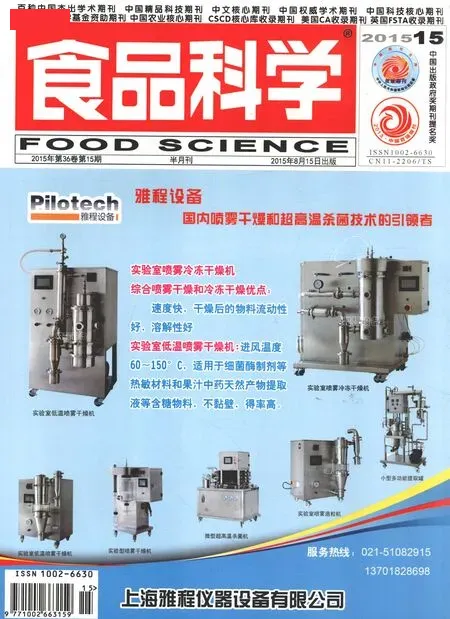食品中多酚形態的研究進展
顏才植,葉發銀,趙國華,2,*
(1.西南大學食品 科學學院,重慶 400715;2.重慶市特色食品工程技術研究中心,重慶 400715)
食品中多酚形態的研究進展
顏才植1,葉發銀1,趙國華1,2,*
(1.西南大學食品 科學學院,重慶 400715;2.重慶市特色食品工程技術研究中心,重慶 400715)
近年來,植物多酚因其存在的普遍性、對食品品質形成的重要性以及眾多的生理活性,已成為食品科學和營養學研究的一個熱點。多酚以游離態和結合態兩種形態存在于食品中。大量研究表明,植物多酚對食品 品質及健康功能的貢獻,不僅取決于其種類和數量,而且取決于其在食品基質中的存在形態。本文在廣泛調研文獻的基礎上,對食品中多酚形態,不同形態多酚的分析方法,常見食品(谷物、水果、蔬菜、可食花卉、其他食品)中游離態多酚與結合態多酚的含量,以及食品加工對多酚形態的影響進行總結,并對食品中多酚形態研究存在的問題及其發展方向進行闡述。
游離態多酚;結合態多酚;形態;分析;加工
多酚(polyphenols)是廣泛存在于可食性植物組織中的一類植物化學物質(phytochemicals),它被證實具有抗氧化活性,能有效預防高血脂、高血糖、心腦血管疾病、腫瘤等慢性疾病。近20 年來,在食品營養學和預防醫學領域,大量研究表明,多酚對人體健康的促進作用不僅與多酚在食品中的種類和數量相關,而且與其在食品基質中的存在形態密切相關。其存在形態甚至影響到我們對多酚在食品中的種類和數量的定量分析。過去大多數測定多酚含量的方法是采用溶劑直接萃取后進行定量分析。此法只能測定可萃取多酚,對于那些與食品基質結合緊密的多酚則無法測定,因此測定結果往往明顯低于其實際含量。Krygvier等[1]率先提出結合態多酚的概念,即需要通過堿水解才能萃取的多酚。Krygier等提供了精確測定游離態多酚和結合態多酚的方法,其研究被人們廣泛重視,結合態多酚逐漸成為多酚研究的一個重要方面[2-4]。多酚形態與其健康效應的關系以及通過加工改變多酚形態以提升其生物利用度的研究已有大量報道和綜述,本文不再贅述;而有關食品中不同形態多酚的比例以及加工對其形態變化的影響規律方面的研究較為薄弱,因此本文對食品中多酚的存在形態、分析方法,以及加工對多酚形態的影響進行綜述,以期為膳食多酚對食品品質形成影響的深入研究提供參考。
1 食品中多酚的形態及其分析方法
1.1食品中多酚形態的劃分
多酚在食品基質中的存在形式即為多酚的形態,食品多酚的形態對于其溶解性、可萃取性、生物活性、人體利用度以及在食品中的應用等方面都有重要的影響。可根據多酚的存在形態將其分為游離態多酚和結合態多酚。游離態多酚是以單體形式被物理吸附或截留于食品基質中的多酚,其游離形態表現出了良好的溶解性,易溶于水或有機溶劑。結合態多酚是經由共價鍵與食品基質(如細胞壁物質)相結合的多酚,具有難萃取的特點。食品中與多酚結合的細胞壁物質主要包括木聚糖(存在于小麥[2]、玉米[2]、大麥[2]等)、阿拉伯木聚糖(存在于甜菜[3]、玉米皮[3]等)、纖維素(存在于甜菜[3]、玉米皮[3]等)、木質素(存在于竹筍[4]等)、果膠(存在于菠菜[5]、甜菜[5]等)、半纖維素(存在于麩皮[4]等)和某些蛋白質(存在于玉米皮[3]、谷粒[4]等)。糧谷類食品中的結合態多酚研究報道較多,主要包括阿魏酸、香豆酸、羥基肉桂酸、可水解單寧等與多糖類物質共價結合的酚酸類物質。
1.2食品中多酚形態的分析
食品中的游離態多酚可通過選擇合適的溶劑直接萃取后進行定量(比色法或色譜法)分析,而結合態多酚由于被細胞壁物質束縛而無法被溶劑直接萃取。故結合態多酚只有先采用合適的水解方式(堿、酸、酶)使其釋放為游離態再進行萃取分析。因此,食品中多酚形態的分析流程一般分為兩步:一是目標對象經干燥脫脂后直接使用適當溶劑萃取,萃取液用于分析游離態多酚;二是對殘渣進行適當水解,釋放出結合態多酚再對其進行萃取分析。
水解釋放是結合態多酚分析的關鍵步驟,常用的水解方法包括堿水解、酸水解和酶水解。酸水解主要是通過破壞糖苷鍵來釋放結合態多酚,但不能釋放通過酯鍵結合的多酚;同時酸水解往往需要較高的溫度,這會導致多酚發生降解而流失。而堿水解可在室溫條件下進行,多酚降解流失少,并且能同時釋放通過糖苷鍵和酯鍵而結合的多酚[6]。目前報道的堿水解的文獻數量遠遠多于酸水解和酶水解的數量,但沒有確鑿證據評定何種方法更好。在結合態多酚的分析研究中,堿水解的使用頻率明顯高于酸水解,尤其是谷物中結合態多酚的測定一般都采用堿水解方式。Krygier等[1]發現酸水解可導致玉米中酚酸的損失高達78%,而堿水解的只有4.8%。酶水解由于酶的特異性原因,其普適性較差,常用的酶包括β-葡萄糖氧化酶、淀粉酶、果膠酶、纖維素酶、半纖維素酶、細胞壁降解酶等[7-8]。商業果膠酶和酯酶制劑已經應用于甜菜渣中的結合態多酚的水解[9],木聚糖酶和酯酶被用于大麥中的酚酸提取[10]。Zheng Huzhe等[8]使用纖維素酶、β-葡聚糖酶、半纖維素酶、木聚糖酶等一系列碳水化合物酶提取青蘋果中的多酚,其中香豆酸,阿魏酸和咖啡酸的提取量較非酶水解空白組分別提高了8、4、32 倍。圖1給出了食品中多酚形態分析常用的流程。

圖1 食品中多酚形態分析的常用流程Fig.1 General analysis procedures for polyphenol forms in foods
2 常見食品中多酚的形態分布
2.1谷物食品
由表1可知,除Shao Yafang等[11]報道的3 種大米,Chandrasekara等[12]報道的5 種粟(黍)以及Alu'datt等[13]報道的亞麻仁與大豆外,其他糧谷類食物中結合態多酚的含量都明顯高于游離態多酚,尤其是玉米及小麥產品中,大多數分析結果都表明其結合態多酚占總多酚的比例超過了90%,有的甚至達到了99.8%[14]。但同時也發現,對不同來源的同一種食物的分析結果存在較大差異,如在玉米籽粒中,Gutiérrez-Uribe[15]和Irakli[16]等的結果表明,游離酚的含量占總多酚的比例在0.5%~0.8%之間,Adom等[17]的結果卻高達13.6%,這可能與樣品來源及分析操作方法有密切關系。

表1 谷物類食品中游離態多酚與結合態多酚的含量及比例Table 1 Contents and percentages of free and bound polyphenols in cereals
2.2水果
表2給出了常見水果中游離態多酚與結合態多酚的含量與比例。除了Vinson等[21]報道的香蕉、藍莓、哈密瓜、櫻桃、白葡萄、甜瓜、油桃、桔子外,其他水果中游離態多酚含量均高于結合態多酚,尤其是在一些顏色較深或酸澀味較重的水果中,分析結果表明其游離態多酚占總多酚的比例可超過90%。對不同來源的同一種水果的分析結果也存在著差異。對比Vinson[21]和Sun Jie[22]等的結果發現,蘋果、香蕉、梨子、檸檬、草莓、桃子在多酚的含量或比例上有明顯的差異,但對于菠蘿分析結果的差異就很小。筆者推測造成此情況的原因可能與品種、來源、貯藏或分析過 程中的多酚降解、分析方法(如水解方式等)的不同有關。
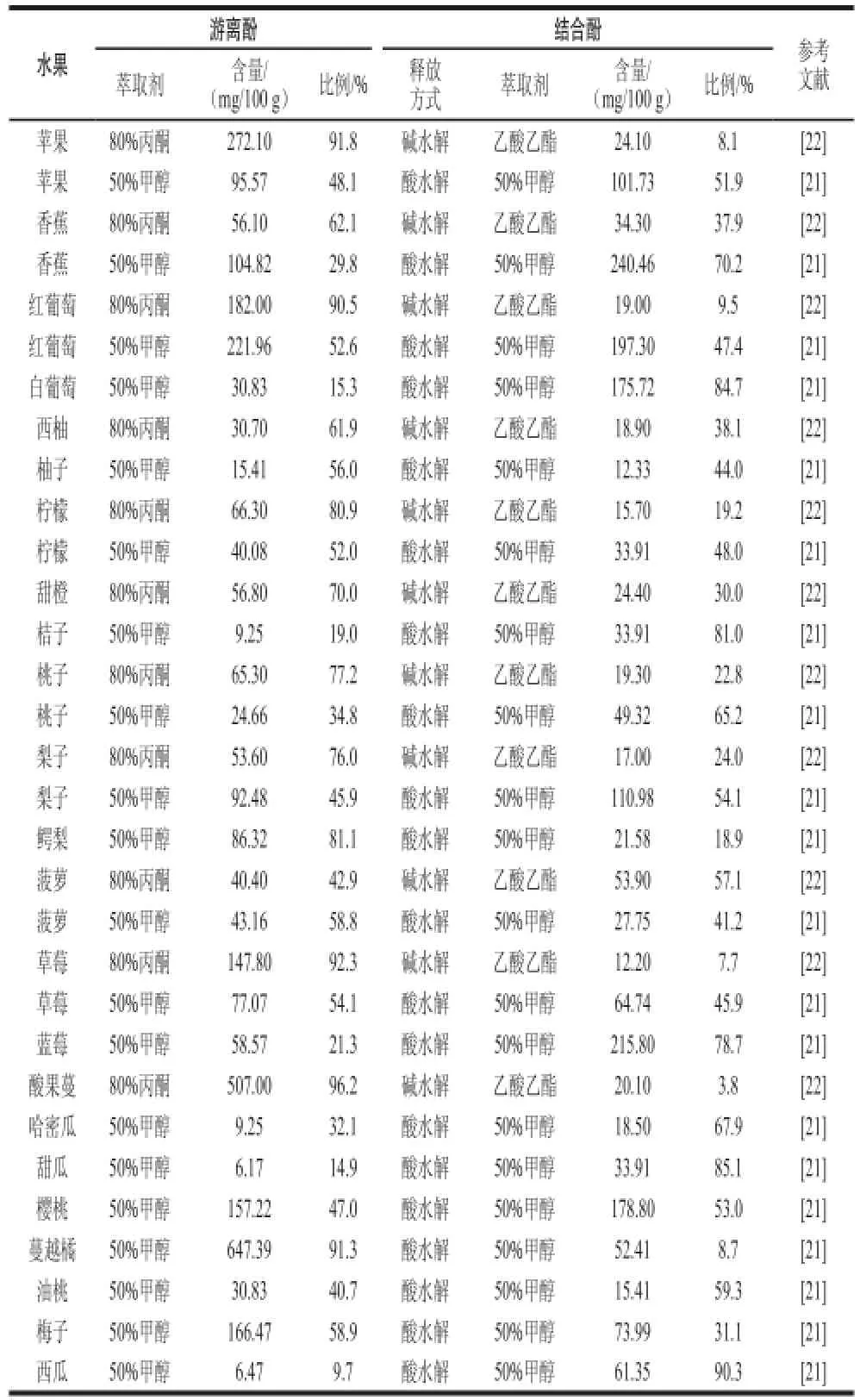
表2 常見水果中游離態多酚與結合態多酚含量及比例Table 2 Contents and percentages of free and bound polyphenols in common fruits uits
2.3蔬菜
表3給出了常見蔬菜類食物中游離態多酚與結合態多酚的含量與比例。各種蔬菜的食用部分不同,由表3可知,花、葉相比于根、莖是多酚更易富集的部位。Hervert-Herná ndez[23]和Albishi[24]等的報道都說明了品種對于蔬菜中多酚的含量和比例有著重要的影響。同時,同一種蔬菜的不同組織中的多酚含量差異明顯[24-27]。
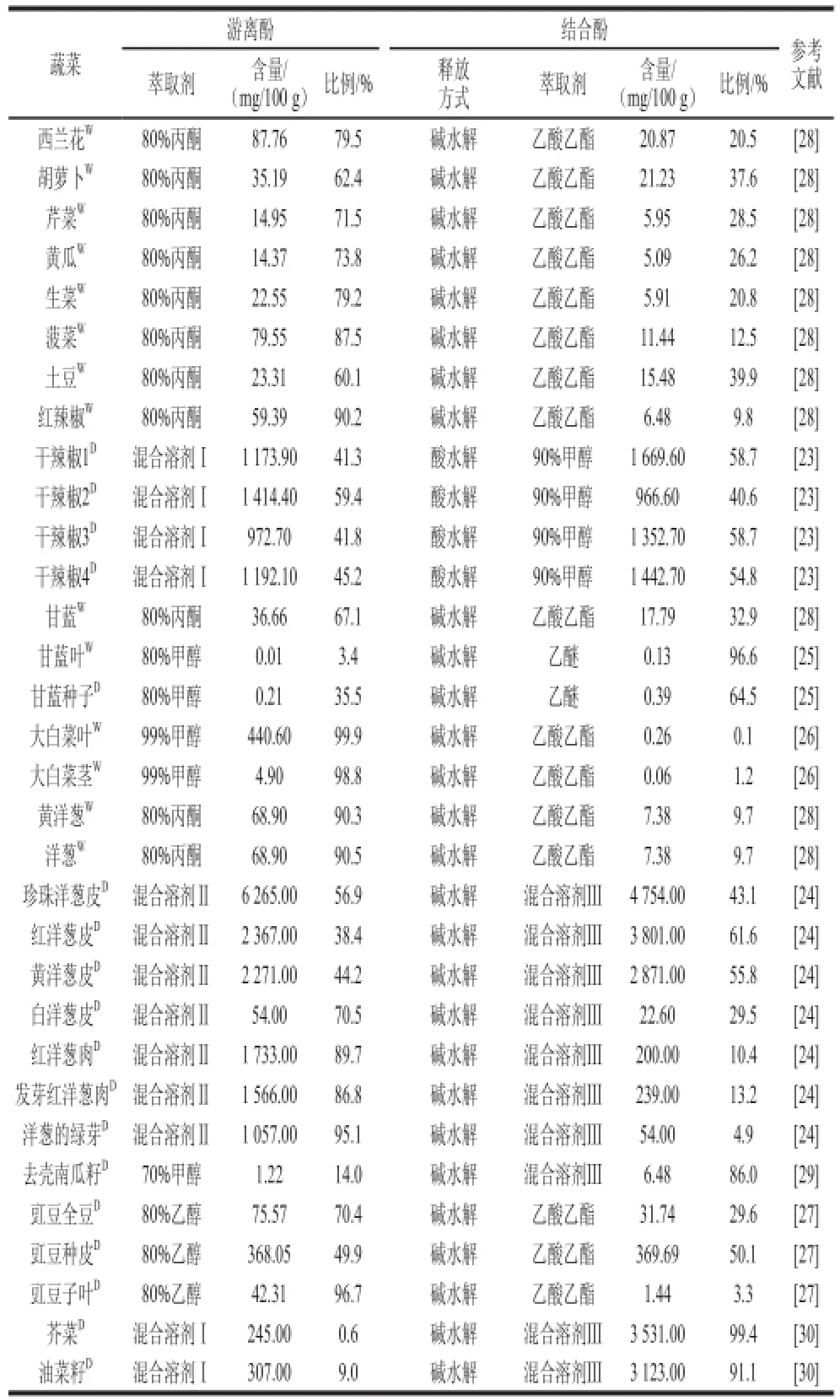
表3 常見蔬菜中游離態多酚與結合態多酚的含量及比例Table 3 Contents and percentages of free and bound polyphenols in common vegetables
2.4可食花卉
表4給出了Kaisoon等[31]研究的一些可食花卉中的游離態多酚與結合態多酚的含量與比例。由表4可知,大部分可食花卉中的多酚含量都不高,并且在比例分布上并無明顯的規律。可食花卉是一種潛力巨大的食品原料,但對其多酚等活性成分的研究還需進一步深入。

表4 常見可食花卉中游離態多酚與結合態多酚的含量及比例Table 4 Contents and percentages of free and bound polyphenols in some edible flowers
2.5其他食品
表5給出了一些食物中游離態多酚與結合態多酚的含量與比例。Gruz等[32]的結果顯示,枸杞在生長過程中,游離態多酚含量幾乎沒有變化,但結合態多酚含量卻逐漸降低。Chandrasekara等[33]的研究結果說明同一食品原料的不同部位的多酚含量可能存在巨大差異,這與表4中呈現的結果一致。
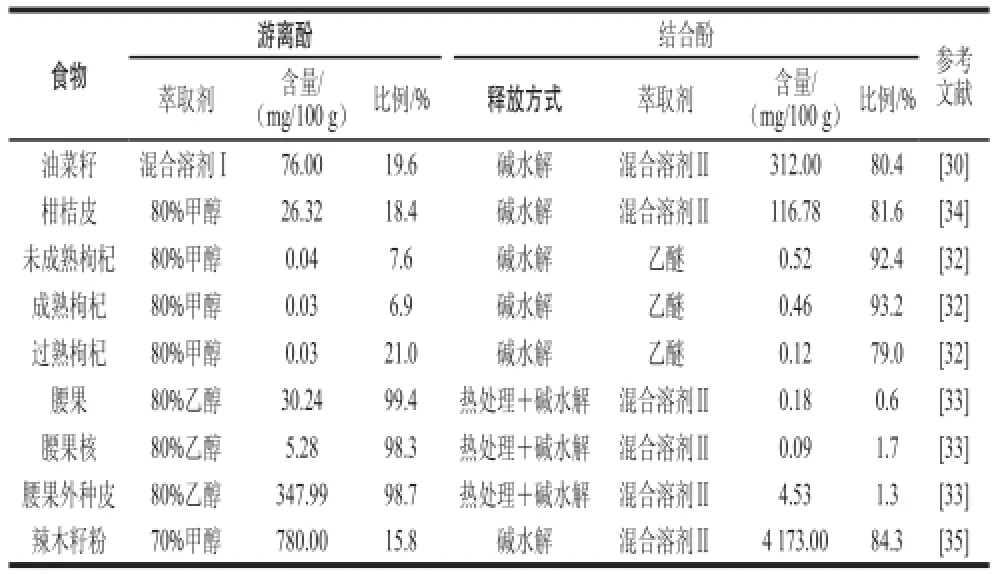
表5 其他食物中游離態多酚與結合態多酚的含量及比例Table 5 Contents and percentages of free and bound polyphenols in some other foods
3 加工對食品中多酚形態的影響
有大量研究報道表明,多種加工處理方式對食品中的多酚形態往往具有顯著影響。在大多數情況下,食品加工處理能使結合態多酚部分轉化為游離態多酚,從而使游離態多酚含量上升而使結合態多酚含量下降。究其原因,主要是在食品加工過程中由于酸水解、堿水解、酶水解、熱降解、機械化作用等使多酚與細胞壁物質之間的共價作用或非共價作用解除,而導致結合態多酚向游離態多酚轉化。糙米在不同溫度條件下貯藏會導致其中的多酚形態發生不同的變化。37 ℃條件下貯藏6 個月的實驗發現糙米中結合酚比例由32%降至29%。游離態阿魏酸含量幾乎不變,結合態阿魏酸含量下降13%;游離態香豆酸含量增加1 倍,結合態對香豆酸含量下降37%;游離態沒食子酸含量增加5 倍,結合態沒食子酸幾乎全部消失;游離態香草酸含量有所增加,結合態香草酸含量下降超過50%。而低溫(4 ℃)貯藏6 個月糙米中結合酚比例由32%下降至31%。游離態阿魏酸含量略微上升,結合態阿魏酸含量下降12%;游離態香豆酸含量增加2.4 倍,結合態對香豆酸含量減少33.3%;游離態沒食子酸含量增加6 倍,結合態沒食子酸幾乎全部消失;游離態香草酸含量略有增加,結合態香草酸含 量下降超過50%[19]。表6給出了一些常見食品加工方式對多酚形態的影響。
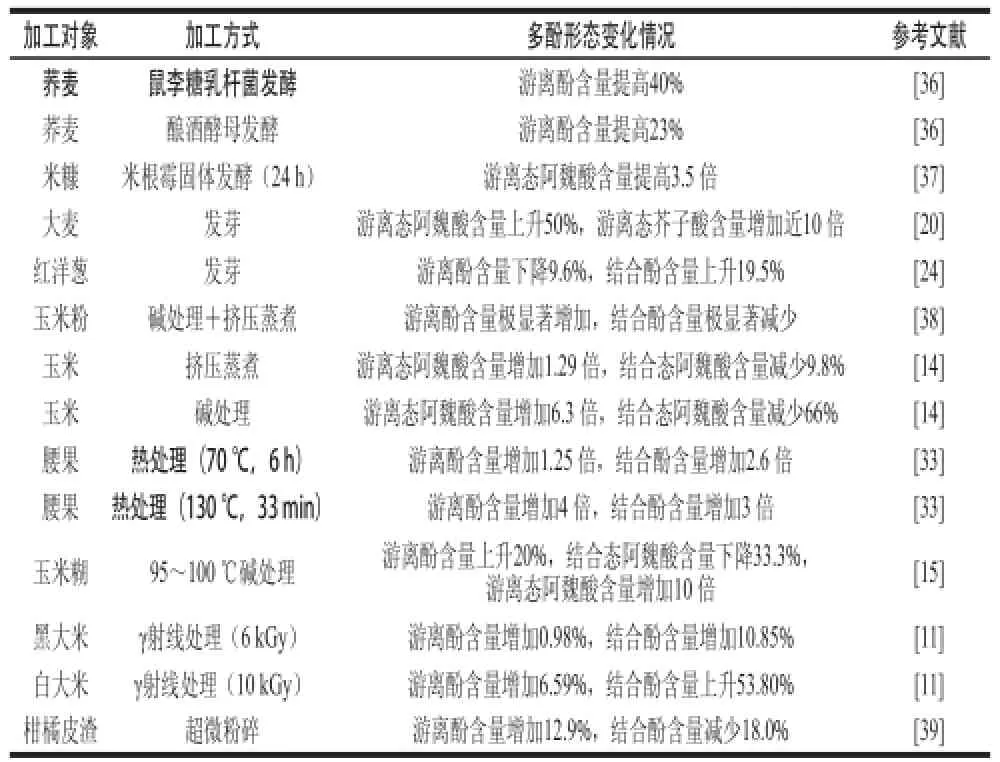
表6 加工處理對食品中多酚形態的影響Table 6 Effect of food processing on forms of polyphenols
4 結 語
綜上所述,食品多酚形態的研究近年來取得了快速的進步與質的飛躍,尤其在多酚形態的定義、分析、各類食品中不同形態多酚的含量普查等多方面有了快速的積累。結合當前的研究狀況,后續有關食品中多酚形態的研究可從以下幾個方面加強或深入:1)更為標準化的多酚形態分析方法的研究;2)食品原料生產的環境條件(如干旱、肥料等)對農產品中多酚形態及含量的影響;3)食品及其原料在貯藏和加工過程中多酚形態的變化需進一步深入,并明確其變化的機制;4)游離態多酚與結合態多酚在發揮生物活性方面的相互作用機制(協同增效);5)食品中多酚形態的調節技術與方法研究。
[1] KRYGIER K, SOSULSKI F, HOGGE L. Free, esterified, and insoluble-bound phenolic acids. 1. Extraction and purification procedure[J]. Journal of Agricultural and Food Chemistry, 1982,30(2): 330-334.
[2] WONG D W S. Feruloyl esterase[J]. Applied Biochemistry and Biotech nology, 2006, 133(2): 87-112.
[3] SAULNIER L, THIBAULT J F. Ferulic acid and diferulic acids as components of sugar-beet pectins and maize bran heteroxylans[J]. Journal of the Science of Food and Agriculture, 1999, 79(3): 396-402.
[4] LIYANA-PATHIRANA C M, SHAHIDI F. Importance of insolublebound phenolics to antioxidant prop erties of wheat[J]. Journal of Agricultural and Food Chemistry, 2006, 54(4): 1256-1264.
[5] COLQUHOUN I J, RALET M C, THIBAULT J F, et al. Structure identification of feruloylated oligosaccharides from sugar-beet pulp by NMR spectroscopy[J]. Carbohydrate Research, 1994, 263(2): 243-256.
[6] KIM K H, TSAO R, YANG R, et al. Phenolic acid profiles and antioxidant activities of wheat bran extracts and the effect of hydrolysis conditions[J]. Food Chemistry, 2006, 95(3): 466-473.
[7] LANDBO A K, MEYER A S. Enzyme-assisted extraction of antioxidative phenols from black currant juice press residues (Ribes nigrum)[J]. Journal of Agricultural and Food Chemistry, 2001, 49(7):3169-3177.
[8] ZHENG Huzhe, HWANG I W, CHUNG S K. Enhancing polyphenol extraction from unripe apples by carbohydrate-hydrolyzing enzymes[J]. Journal of Zhejiang University: Science B, 2009, 10(12):912-919.
[9] FAZARY A E, JU Y H. Feruloyl esterases as biotechnological tools:current and future perspectives[J]. Acta Biochimica et Biophysica Sinica, 2007, 39(11): 811-828.
[10] SANCHO A I, BARTOLOM? B, G?MEZ-CORDOV?S C, et al. Release of ferulic acid from cereal residues by barley enzymatic extracts[J]. Journal of Cereal Science, 2001, 34(2): 173-179.
[11] SHAO Yafang, TANG Fufu, XU Feifei, et al. Effects of γ-irradiation on phenolics content, antioxidant activity and physicochemical properties of whole grainrice[J]. Radiation Physics and Chemistry,2013, 85: 227-233.
[12] CHANDRASEKARA A, SHAHIDI F. Content of insoluble bound phenolics in millets and their contribution to antioxidant capacity[J]. Journal of Agricultural and Food Chemistry, 2010, 58(11): 6706-6714.
[13] ALU'DATT M H, RABABAH T, EREIFEJ K, et al. Phenolic: protein interactions in oilseed protein isolates[J]. Food Research International,2013, 52(1): 178-184.
[14] MORA-ROCHIN S, GUTI?RREZ-URIBE J A, SERNASALDIVAR S O, et al. Phenolic content and antioxidant activity of tortillas produced from pigmented maize processed by conventional nixtamalization or extrusion cooking[J]. Journal of Cereal Science,2010, 52(3): 502-508.
[15] GUTI?RREZ-URIBE J A, ROJAS-GARC?A C, GARC?A-LARA S,et al. Phytochemical analysis of wastewater (nejayote) obtained after lime-cooking of different types of maize kernels processed into masa for tortillas[J]. Journal of Cereal Science, 2010, 52(3): 410-416.
[16] IRAKLI M N, SAMANIDOU V F, BILIADERIS C G, et al. Development and validation of an HPLC-method for determination of free and bound phenolic acids in cereals after solid-phase extraction[J]. Food Chemistry, 2012, 134(3): 1624-1632.
[17] ADOM K K, LIU Ruihai. Antioxidant activity of grains[J]. Journal of Agricultural and Food Chemistry, 2002, 50(21): 6182-6187.
[18] LOPEZ-MARTINEZ L X, OLIART-ROS R M, VALERIO-ALFARO G, et al. Antioxidant activity, phenolic compounds and anthocyanins content of eighteen strains of Mexican maize[J]. LWT-Food Science and Technology, 2009, 42(6): 1187-1192.
[19] ZHOU Zhongkai, ROBARDS K, HELLIWELL S, et al. The distribution of phenolic acids in rice[J]. Food Chemistry, 2004, 87(3):401-406.
[20] DVO??KOV? M, GUIDO L F, DOST?LEK P, et al. Antioxidant properties of free, soluble ester and insoluble-bound phenolic compounds in different barley varieties and corresponding malts[J]. Journal of the Institute of Brewing, 2008, 114(1): 27-33.
[21] VINSON J A, SU Xuehui, ZUBIK L, et al. Phenol antioxidant quantity and quali ty in foods: fruits[J]. Journal of Agricultural and Food Chemistry, 2001, 49(11): 5315-5321.
[22] SUN Jie, CHU Yifang, WU Xianzhong, et al. Antioxidant and antiproliferative activities of common fruits[J]. Journal of Agricultural and Food Chemistry, 2002, 50(25): 7449-7454.
[23] HERVERT-HERNA?NDEZ D, SA?YAGO-AYERDI S G, GONI I. Bioactive compounds of four hot pepper varieties (Capsicum annuum L.),antioxidant capacity, and intestinal bioaccessibility[J]. Journal of Agricultural and Food Chemistry, 2010, 58(6): 3399-3406.
[24] ALBISHI T, JOHN J A, AL-KHALIFA A S, et al. Antioxidative phenolic constituents of skins of onion varieties and their activities[J]. Journal of Functional Foods, 2013, 5(3): 1191-1203.
[25] AYAZ F A, HAYIRLIOGLU-AYAZ S, ALPAY-KARAOGLU S, et al. Phenolic acid contents of kale (Brassica oleraceae L. var. acephala DC.) extracts and their antioxidant and antibacterial activities[J]. Food Chemistry, 2008, 107(1): 19-25.
[26] HARBAUM B, HUBBERMANN E M, ZHU Zhujun, et al. Free and bound phenolic compounds in leaves of pak choi (Brassica campestris L. ssp. chinensis var. communis) and Chinese leaf mustard (Brassica juncea Coss)[J]. Food Chemistry, 2008, 110(4): 838-846.
[27] GUTI?RREZ-URIBE J A, ROMO-LOPEZ I, SERNA-SALD?VAR S O. Phenolic composition and mammary cancer cell inhibition of extracts of whole cowpeas (Vigna unguiculata) and its anatomical parts[J]. Journal of Functional Foods, 2011, 3(4): 290-297.
[28] CHU Yifang, SUN Jie, WU Xianzhong, et al. Antioxidant and antiproliferative activities of common vegetables[J]. Journal of Agricultural and Food Chemistry, 2002, 50(23): 6910-6916.
[29] PERI?IN D, KRIMER V, TRIVI? S, et al. The distribution of phenolic acids in pumpkin's hull-less seed, skin, oil cake meal,dehulled kernel and hull[J]. Food Chemistry, 2009, 113(2): 450-456.
[30] NACZK M, WANASUNDARA P, SHAHIDI F. Facile spectrophotometric quantification method of sinapic acid in hexaneextracted and methanol-ammonia-water-treated mustard and rapeseed meals[J]. Journal of Agricultural and Food Chemistry, 1992, 40(3):444-448.
[31] KAISOON O, SIRIAMORNPUN S, WEERAPREEYAKUL N, et al. Phenolic compounds and antioxidant activities of edible flowers from Thailand[J]. Journal of Functional Foods, 2011, 3(2): 88-99.
[32] GRUZ J, AYAZ F A, TORUN H, et al. Phenolic acid content and radical scavenging activity of extracts from medlar (Mespilus germanica L.) fruit at different stages of ripening[J]. Food Chemistry,2011, 124(1): 271-277.
[33] CHANDRASEKARA N, SHAHIDI F. Effect of roasting on phenolic content and antioxidant activities of whole cashew nuts, kernels, and testa[J]. Journal of Agricultural and Food Chemistry, 2011, 59(9):5006-5014.
[34] XU Guihua, YE Xingqian, CHEN Jianchu, et al. Effect of heat treatment on the phenolic compounds and antioxidant capacity of citrus peel extract[J]. Journal of Agricultural and Food Chemistry,2007, 55(2): 330-335.
[35] SINGH R S G, NEGI P S, RADHA C. Phenolic composition,antioxidant and antimicrobial activities of free and bound p henolic extracts of Moringa oleifera seed flour[J]. Journal of Functional Foods, 2013, 5(4): 1883-1891.
[36] DORDEVIC T M, SILER-MARINKOVIC S S, DIMITRIJEVICBRANKOVIC S I. Effect of fermentation on antioxidant properties of some cereals and pseudo cereals[J]. Food Chemistry, 2010, 119(3):957-963.
[37] OLIVEIRA M S, CIPOLATTI E P, FURLONG E B, et al. Phenolic compounds and antioxidant activity in fermented rice (Oryza sativa)bran[J]. Food Science and Technology, 2012, 32(3): 531-537.
[38] GODOYC ? V O, L?PEZ-VALENZUELAA J A, DELGADOVARGASA F, et al. Nutraceutical beverage from a high antioxidant activity mixture of extruded whole maize and chickpea flours[J]. European International Journal of Science and Technology, 2012, 1(3): 1-14.
[39] TAO Bingbing, YE Fayin, LI Hang, et al. Phenolic profile and in vitro antioxidant capacity of insoluble dietary fiber powders from citrus (Citrus junos Sieb. ex Tanaka) pomace as affected by ultrafine grinding[J]. Journal of Agricultural and Food Chemistry, 2014, 62(29):7166-7173.
A Review of Studies on Free and Bound Polyphenols in Foods
YAN Caizhi1, YE Fayin1, ZHAO Guohua1,2,*
(1. College of Food Science, Southwest University, Chongqing 400715, China;2. Chongqing Special Food Programme and Technology Research Center, Chongqing 400715, China)
In recent years, plant polyphenols have become a hotspot in food science and nutrition because of the universal presence and importance for food quality and biological activities. Polyphenols in foods can fall into two categories, i.e.,free and bound polyphenols. Many studies have shown that the contribution of plant polyphenols to food quality and healt h function depends not only on their categories and amounts, but also on forms existing in food matrixes. The existing forms,analytic methods, free and bound polyphenol contents in various foods (cerea ls, fruits, vegetables, edible flowers and others)and the effects of processing on the existing forms of food polyphenols are summarized. Moreover, the existing problems and future prospects of research on free and bound polyphenols in foods are elaborated.
free polyphenols; bound polyphenols; form; analysis; processing
TS201.2
A
1002-6630(2015)15-0249-06
10.7506/spkx1002-6630-201515046
2015-03-23
國家自然科學基金面上項目(31371737);重慶市特色食品工程技術研究中心能力提升項目(cstc2014pt-gc8001)
顏才植(1990—),男,碩士研究生,研究方向為食品化學。E-mail:yancaizhi1990@163.com
趙國華(1971—),男,教授,博士,研究方向為食品化學與營養。E-mail:zhaoguohua1971@163.com

